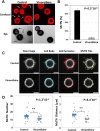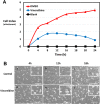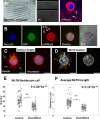Microtubule disruption reduces metastasis more effectively than primary tumor growth
- PMID: 35164808
- PMCID: PMC8842877
- DOI: 10.1186/s13058-022-01506-2
Microtubule disruption reduces metastasis more effectively than primary tumor growth
Abstract
Clinical cancer imaging focuses on tumor growth rather than metastatic phenotypes. The microtubule-depolymerizing drug, Vinorelbine, reduced the metastatic phenotypes of microtentacles, reattachment and tumor cell clustering more than tumor cell viability. Treating mice with Vinorelbine for only 24 h had no significant effect on primary tumor survival, but median metastatic tumor survival was extended from 8 to 30 weeks. Microtentacle inhibition by Vinorelbine was also detectable within 1 h, using tumor cells isolated from blood samples. As few as 11 tumor cells were sufficient to yield 90% power to detect this 1 h Vinorelbine drug response, demonstrating feasibility with the small number of tumor cells available from patient biopsies. This study establishes a proof-of-concept that targeted microtubule disruption can selectively inhibit metastasis and reveals that existing FDA-approved therapies could have anti-metastatic actions that are currently overlooked when focusing exclusively on tumor growth.
Keywords: Breast cancer; Circulating tumor cells; MDA-MB-231; Metastasis; Microtentacles; Reattachment; Vinorelbine.
© 2022. The Author(s).
Conflict of interest statement
The University of Maryland has patents pending on the microfluidic cell tethering technology on which K.R.C, C.M.J. and S.S.M. are listed as inventors. S.S.M and C.M.J. are employees of the VA Maryland Health Care System. The views reported in this paper do not reflect the views of the Department of Veterans Affairs or the United States Government.
Figures







Similar articles
-
ROCK inhibition promotes microtentacles that enhance reattachment of breast cancer cells.Oncotarget. 2015 Mar 20;6(8):6251-66. doi: 10.18632/oncotarget.3360. Oncotarget. 2015. PMID: 25749040 Free PMC article.
-
Parthenolide and costunolide reduce microtentacles and tumor cell attachment by selectively targeting detyrosinated tubulin independent from NF-κB inhibition.Breast Cancer Res. 2013;15(5):R83. doi: 10.1186/bcr3477. Breast Cancer Res. 2013. PMID: 24028602 Free PMC article.
-
Anti-tubulin agent vinorelbine inhibits metastasis of cancer cells by regulating epithelial-mesenchymal transition.Eur J Med Chem. 2020 Aug 15;200:112332. doi: 10.1016/j.ejmech.2020.112332. Epub 2020 May 13. Eur J Med Chem. 2020. PMID: 32473523
-
Vimentin filaments support extension of tubulin-based microtentacles in detached breast tumor cells.Cancer Res. 2008 Jul 15;68(14):5678-88. doi: 10.1158/0008-5472.CAN-07-6589. Cancer Res. 2008. PMID: 18632620 Free PMC article.
-
Vinorelbine's anti-tumor actions may depend on the mitotic apoptosis, autophagy and inflammation: hypotheses with implications for chemo-immunotherapy of advanced cancers and pediatric gliomas.J Chemother. 2018 Jul;30(4):203-212. doi: 10.1080/1120009X.2018.1487149. Epub 2018 Jul 20. J Chemother. 2018. PMID: 30025492 Review.
Cited by
-
Hydrogen Peroxide Induces α-Tubulin Detyrosination and Acetylation and Impacts Breast Cancer Metastatic Phenotypes.Cells. 2023 Apr 27;12(9):1266. doi: 10.3390/cells12091266. Cells. 2023. PMID: 37174666 Free PMC article.
-
An Image-Based Identification of Aggressive Breast Cancer Circulating Tumor Cell Subtypes.Cancers (Basel). 2023 May 9;15(10):2669. doi: 10.3390/cancers15102669. Cancers (Basel). 2023. PMID: 37345005 Free PMC article.
-
Combination Therapy as a Promising Way to Fight Oral Cancer.Pharmaceutics. 2023 Jun 4;15(6):1653. doi: 10.3390/pharmaceutics15061653. Pharmaceutics. 2023. PMID: 37376101 Free PMC article. Review.
-
Isolation and Anticancer Progression Evaluation of the Chemical Constituents from Bridelia balansae Tutcher.Molecules. 2023 Aug 21;28(16):6165. doi: 10.3390/molecules28166165. Molecules. 2023. PMID: 37630417 Free PMC article.
-
High-Efficiency Inertial Separation of Microparticles Using Elevated Columned Reservoirs and Vortex Technique for Lab-on-a-Chip Applications.ACS Omega. 2023 Jul 25;8(31):28628-28639. doi: 10.1021/acsomega.3c03136. eCollection 2023 Aug 8. ACS Omega. 2023. PMID: 37576636 Free PMC article.
References
-
- Pantel K, Alix-Panabieres C. Liquid biopsy and minimal residual disease—latest advances and implications for cure. Nat Rev Clin Oncol. 2019;16:409–424. - PubMed
-
- Cristofanilli M, Budd GT, Ellis MJ, Stopeck A, Matera J, Miller MC, Reuben JM, Doyle GV, Allard WJ, Terstappen LW, et al. Circulating tumor cells, disease progression, and survival in metastatic breast cancer. N Engl J Med. 2004;351(8):781–791. - PubMed
Publication types
MeSH terms
Substances
Grants and funding
LinkOut - more resources
Full Text Sources
Medical
Research Materials
Miscellaneous

